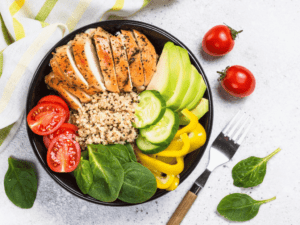The core component of everyone’s nutrition who works out regularly is a steady intake of protein. Whether it be through protein-packed foods like chicken or nuts, quick and easily made protein shakes, or running over to your favorite restaurant to get a protein-packed meal in. But what are the benefits of eating protein?
Here are the top 6 benefits of eating protein after working out and why so many people do it.
1. Help with Recovery
The first and foremost reason to intake protein is to aid in your recovery times. When we workout, we breakdown the muscle by creating tiny tears in the body. Our muscles are made up of amino acids, and amino acids are the building blocks of proteins.
By intaking it after a workout, you’re supplying the body with the material it needs to come back stronger and rebuild. Think about your body as a building that gets damaged while you workout, and the protein that you’re eating is the concrete and other materials needed to fix the building.
Beyond repairing, it also gives the body the amino acids it needs to create new muscle tissue. So rather than fixing your building to where it was, it also extends your building, making it appear more appealing.
If you’re looking for easy post-workout meals, check out the recipes that are listed on our blog.
2. Restore Energy
When you eat protein, you typically get a set number of carbs into your diet as well. This is also important to have post-workout, as your body will burn through its glycogen storage throughout the workout. That is why certain studies stand by drinking chocolate milk after working out.
The intake of carbs along with protein from milk is a great way to ensure that your body is getting the energy it needs to recover. Without a good energy source, you can delay recovery for longer periods of time, as you won’t be able to get up and go like you need to.
Protein also kicks start thermogenesis more effectively than fats and carbs. So if you’ve had an adequate amount of protein after working out, your body will start to utilize calories that are sitting around to give it the energy it needs to keep going.
3. Build Lean Muscle
A good post-workout routine not only helps the body recover but helps pack on new muscle tissue. Our skeletal muscle is the muscles that we think of when we see someone shredded at the gym. While for some, it comes naturally, the majority of people need to have the right nutrition to get bigger and stronger.
A high protein diet is a key to ensuring that your body starts that process of building muscle. Lean muscle also comes with more benefits beyond just looking bigger.
Lean muscle is one of the best ways to ensure that your body burns more calories. The higher the lean muscle mass you carry, the faster your overall metabolism is going to be. Your body wants to keep up with its current metabolism rather than slowing down, so you’ll need to adjust calories as you pack on more muscle mass.
4. Keeps Your Immune System Up
Protein has a high amount of the amino acid L-glutamine within it. In fact, it is the main amino acid that makes up the majority of the protein you eat. There are a few exceptions to that rule, though.
L-glutamine is a key component of more than just muscles; it also plays a big role in how our immune system functions. This amino acid is a fuel source for important functions like our white blood cells. When there is an adequate amount of protein in the diet, our immune system tends to function as well as it can.
Those that are dealing with major burns also take in high amounts of L-glutamine, as it boosts the immune system to help with the recovery process.
5. Helps With Satiation
Protein is the macronutrient with the highest satiation level. This is thanks to its ability to be utilized for its amino acids rather than its calories, unlike fat or carbs, which tend to be better energy sources than recovery sources.
For those that tend to overeat after working out, protein is a great way to help prevent this from happening. Your body does not produce as many enzymes to break down food that is high in protein, making it sit in the intestinal tract for longer periods of time. By not having the enzymes available to break down protein into calories, it then utilizes the protein for amino acids as a recovery agent more effectively.
A good post-workout meal will include protein to ensure that you don’t diminish the work you just put in. It can help keep you fuller for longer, thus allowing your body to burn through its other energy sources before utilizing protein.
6. Increase Thermogenesis
A good fun fact to know is that your body burns most of its calories just by doing its job. That means it burns more calories digesting food, keeping you awake, and simply doing your job than anything you can do at the gym.
The thought process as to why protein is more thermogenic has a few theories. The first one is that the body has no real way to store excess amounts of protein, leading to an increase in amino acid elimination. When this happens, your body increased thermogenesis and energy expenditure, as it now needs calories to eliminate the amino acids.
The other idea is that while protein has calories, it is not utilized as effectively as fats and carbs. This could mean that our body is able to utilize the nutrients that it intakes from protein without the needed impact of extra calories. However, this is still speculation, with more studies needed on the topic.
Keep the Benefits of Eating Protein In Mind While Training
The benefits of eating protein extend past just muscles. It is an important part of keeping the body running, whether it be repairing the body or increasing the energy your body needs to burn.
If you want to learn more about keeping your body in tip-top shape, be sure to read more on our blog. Interested in getting fit like never before? Get in contact with us to find a location near you.




